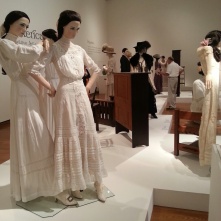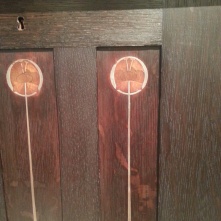This week, we begin David Pye’s The Nature and Art of Workmanship. As we move forward, I am curious to see how this work relates to what we have been discussing about craftsmanship. To me, the move from the root of craft to work is intriguing, and I wonder about the implications of such a focus in term and what this might mean for the process of making and the product made. To provide a really broad gloss, Pye seems to be working to distinguish the difference between design and workmanship, differentiates workmanship of risk vs. certainty on the basis of whether or not “the result is predetermined and unalterable once production begins” (22), the concept of handwork and its meaningless distinction from machine work, and the contrasting qualities of workmanship – precision and approximation, regulation and freedom. This is rather reductionist, as Pye is careful, slow, and deliberate in his prose.
Traces/Scraps of Work
“Design is what, for practical purpose, can be conveyed in words and by drawing; workmanship is what, for practical purposes, can not. In practice the designer hopes the workmanship will be good, but the workman decides whether it shall be good or not” (17).
This was of interest to me because I saw a connection to our conversations in reading Richard Sennett’s work and dwelling in the embodied and tacit knowledge of the craftsman, or now, worksman (I’m really curious as to this shift in terminology and what it meant for identity and making). In this section, “Design Proposes, Workmanship Disposes”, Pye focuses on materials and the dependency of the design on the worksman in what the worksman can make from materials; as Pye describes it, “Material in the raw is nothing much” (18). This seems to continue our focus on a product that is good in quality and in function. The title of this section though has me wondering about material concerns – proposes vs. disposes – and the relationship between designing and making; here, they seem distinct from one another, in two different bodies and processes.
“If I must ascribe a meaning to the word craftsmanship, I shall say as a first approximation that it means simply workmanship using any kind of technique or apparatus, in which the quality of the result is not predetermined, but depends on the judgment, dexterity, and care which the maker exercises as he works” (20).
I find this interesting because I question if Pye’s explanation of a craftsman as a worksman + technique or apparatus works in the opposite – is a craftsman a worksman? Does his vision differ from Sennett? Does Sennett’s craftsman embody design as seen as somewhat removed from Pye’s worksman? I also feel more of an emphasis on tools or apparatus emerging in Pye…What significance might these have on workmanship?
“To distinguish between the different ways of carrying out an operation by classifying them as hand or machine work is, as we shall see, all but meaningless” (25).
In the section “Is Anything Done by Hand?”, Pye works to dissolve the distinction between handwork and work done with tools. He states that “very few things can properly be said to have been made by hand” (29) and that “Handi-craft and Hand-made are historical terms, not technical ones” (26). I continue to be fascinated by the role of machines in making and the tensions that exist between human and thing. After reading Pye, and Sennett as well, the relationship between human and machine is complex, and I’m starting to subdivide machine to explore this relationship.
Work Potential
What I was drawn to in reading is not only Pye’s discussion of techn- and machines/machinery, but how he is defining these concepts and their relationship to making. A goal for reading this text, for me, is to take inventory of all the tech- root words and their iterations through tools, production, and workmanship. This is sort of an obsessive side interest in the use of techn- as techne, technique, technology, technic, and so on and the relationship to the conception of materials and making.















